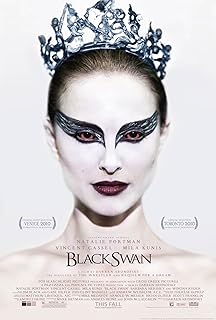
2010-12-28 05:46:35
A Teaching assignment on the mise-en-scene in Black Swan
************這篇影評可能有雷************
I did my teaching lesson this weekend, with my friend Vincent, with whom I share a mutual love for Natalie Portman. We went to AMC movie theatre in Boston and chose the film Black Swan directed by Darren Aronofsky.
The movie shocked me into silence. I did not have any previous knowledge about the film before I watched it. From the eye-catching poster that Natalie standing in the middle like a queen, wearing the black swan tutu with all the black feathers surround, I expected it to be an artistic drama. However it’s psychologically thrilling traits totally blew me away. I was sitting at the back row, holding my scarf to cover my eyes while the scary scene popped out. After the movie, I found myself paralyzed in my perspiration-soaked shirt. I was so exhausted that I could not even stand up from the seat while Natalie’s dance still spinning around in my head. My feeling was as complicated as a farrago: fear, astonishment of the beauty, sadness, expected to be disappear… It was the first time that the film made me forgetting about my spectatorship and defenselessly falling into the mysterious kaleidoscope that the Aronofsky and Natalie together deliberately created for me.
We started our 「Lesson」 after the show. The difficulties was that I could not point out the editing style or ask him to be aware of the changing of camera movements during the film is playing. We could not stop the film in the middle to analyze the misen-en-scene either. Therefore my teaching process was mainly about memorization and talk. I recalled a particular sequence, asked him questions, and explained my thoughts on the concept that we talked about. He listened, and gave me feedbacks. We did have a really enjoyable and thoughtful conversation about Black Swan.
As a fact that I did not have any idea about the film at the first, I asked Vincent to take particular attention to anything he found interesting or strange in the Black Swan. After the movie, we first talked about our general feelings about the movie. (Vincent noticed my strange physical facial expression and he was somehow scared.) He told me that he felt like he was almost sucked into the film, and for some moments he could not even breathe. I was so glad about him having the same feeling as I did. Followed by his answer, I asked him what constituted his feeling and in which moments that he felt most powerful to him. However he was not able to rigorously figure out the traits or factors that make him feel the way he feels. He said: 「It’s just a kind of feeling. I feel that I am absorbed into the story and just… Well, everything in the film makes me feel that way.」 Then I asked him,」what do you mean by 「everything? 」 Have you ever thought about why the so-called 「everything」 made you feel what you feel?」 He thought for a while and could barely answer the question.
Then I started explained him the basic factors of a movie: Mise-en-scene, camera movement, sound, and editing. I did not dig too deep for each concept like we did in class because I was worried if he could learn everything at once. Therefore I decided to talk about the particular sequence that impressed him the most, and then explain how these cinematic factors contribute to his film experience. For example, there was a sequence where Nina (Natalie Portman) is taking a bath. She starts to see a devilish woman coming to her then quickly disappears. She is scared. Then she gets out of the bathtub but the devil voice still exists. She is so terrified. Then she calls her mother. The camera follows her running into different room to find her mother. She enters a room. There are many pictures that seem like kid’s drawing hanging on the wall. She sees the pictures moving, laughing and calling her 『sweetheart.』 Vincent told me that during the sequence, he caught Nina’s fear. The fear was so strong that he felt he was hard to breathe. It was extremely interesting to see how the moving images change and influence on the spectator’s mental and physical condition. Vincent was really aware his own sensation to the sequence as a whole but he has difficulty to decode the 「how」 and 「why」 questions: HOW and WHY does a series moving images have such strong power to control one’s emotion. This question was the key in our conversation. After we figured out in what level Vincent’s ability of consuming a film, I started talking about the factors in this sequence that contribute to the results.
In general, the movie follows the Hollywood continuity code including shot/reverse shot, eyeline-matches, and POV shots to establish the relationships between each character and to build the realism of time and space within the film. The plot and story go alone the same chronicle order. Everything follows a linear story line to make the spectator not to aware about the technique but engage into the story. However in this particular sequence, In order to depict and emphasize Nina’s inner fear, Aronofsky employs montage techniques that features with disjunctive jump cuts to change the rhythm and to create an intensive, desperate, almost grotesque atmosphere. This is why Vincent felt uncomfortable. It was designed to make the spectator re-frame the impression of Nina and the relationship between Nina and her controlling mother, whom seem to be a very sweet caring mother at the first. Going along with editing, I also talked about the difference between Hollywood continuity editing and Montage. Vincent seemed really into it. After editing, we discussed about mise-en-scene. (Vincent loved the term a lot. He thought the pronunciation was really cool. I also translated the term in Chinese but he thought the French version sounds more elegant and professional.) I explained the concept and the formation of mise-en-scene including props, actors, costumes and lights. Then we specifically talked about the utilization of mirror in Black Swan. Mirror was the key object in Black Swan. Aronofsky uses mirror not only because it is a crucial part in Ballerinas』 life that he uses it to enhance the realism of the movie, but also for many deeper meanings. Black Swan is a movie about dualism and ego. The mirror opens many space and possibilities for the director and actor to elaborate themselves into multiple layers. It is emphasized in the sequence where Nina does her swan variations. The dancing room features with two huge mirror walls. The scene starts with a long take of Nina dancing. The camera is not fixed but follows Nina dancing and swings around her just like the camera is dancing too. This piece reminds me of the opening long take of Boogies Nights. I remember that we discussed how the camera spins around with the disco background music and dances for us. (I made this as one of my references when I taught Vince) After the long take, Aronofsky deliberately establishes a camera angle of a close up of 湯瑪士, the artistic director, and it allows us to observe that at the moment 湯瑪士 watching Nina dancing, we could also see Nina from the mirror. In the frame we see 湯瑪士』 face while we can also see the reflection of his back from the mirror. The mirror provides us a chance to see Nina both from 湯瑪士』 gaze, and an outsider’s gaze. However at the same moment the mirror also confuses us and makes us wonder about whom are we really watching at. Is it Nina? Is it Nina’s reflection? Or is it the one that 湯瑪士 expects Nine to be. Vincent loved this sequence very much, and he liked the ideas of using props to tell the spectators something that the characters are enable to tell in the story. We also talked a little bit about the formalism and expressionism of cinema. Vincent came up with the idea that the formalistic traits he found in Black Swan also appear in Citizen Kane.
We ended our three-hours conversation about Black Swan at the Starbucks next to AMC movie theatre. It was really enjoyable. Vincent told me that he was used to simply watch the film for entertainment. He had his reaction for the film but he never thought about why and what factors constitute his feelings, and he had never be aware of the spectatorship, the relation between cinema and spectators. He appreciated our conversation and expected to have it again. On the other hand, I also learned many things during the teaching assignment. I realized that I was actually observing the movie instead of simply watching it. This can probably explain why I found myself so much engaging into the movie. However, there were still confusions that Black Swan left me over. I expected to watch the movie again and see if I could solve all of the puzzles. This experience was amazing.

